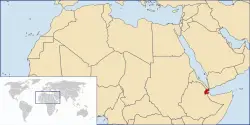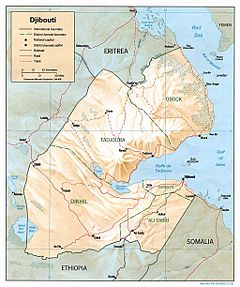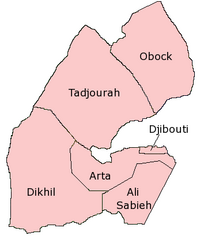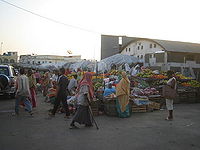Djibouti
| جمهورية جيبوتي Jumhūriyyat Jībūtī Jamhuuriyadda Jabuuti République de Djibouti Republic of Djibouti | |||||
| |||||
| Anthem: Djibouti | |||||
| Capital | Djibouti 11°36′N 43°10′E | ||||
|---|---|---|---|---|---|
| Largest city | capital | ||||
| Official languages | Arabic and French | ||||
| Government | Parliamentary democracy | ||||
| - President | Ismail Omar Guelleh | ||||
| - Prime Minister | Dileita Mohamed Dileita | ||||
| Independence | from France | ||||
| - Date | June 27 1977 | ||||
| Area | |||||
| - Total | 23,200 km² (149th) 8,958 sq mi | ||||
| - Water (%) | 0.09 (20 km² / 7.7 mi²) | ||||
| Population | |||||
| - July 2005 estimate | 793,000 | ||||
| - 2000 census | 460,700 | ||||
| - Density | 34/km² 88/sq mi | ||||
| GDP (PPP) | 2005 estimate | ||||
| - Total | $1.641 billion | ||||
| - Per capita | $2,070 | ||||
| HDI (2004) | 0.494 (low) | ||||
| Currency | Franc (DJF)
| ||||
| Time zone | EAT (UTC+3) | ||||
| - Summer (DST) | not observed (UTC+3) | ||||
| Internet TLD | .dj | ||||
| Calling code | +253 | ||||
Djibouti, officially the Republic of Djibouti, is a small country in eastern Africa. Through close contacts with the Arabian peninsula for more than a thousand years, the Somali and Afar tribes in this region became among the first on the African continent to accept Islam.
Geography
Djibouti is bordered by Eritrea in the north, Ethiopia in the west and south, and Somalia in the southeast. The remainder of the border is formed by the Red Sea and the Gulf of Aden. On the other side of the Red Sea, on the Arabian Peninsula, 12 miles (20 km) from the coast of Djibouti, is Yemen. The capital of Djibouti is Djibouti.
The country, the size of Massachusetts, is mainly a stony desert, with scattered plateaus and highlands.
History
The Republic of Djibouti gained its independence from the French on June 27, 1977. France had colonized it in the early nineteenth century and renamed it Umunga. Independence was claimed once before in 1887 when a local tribe overthrew the eight permanent soldiers stationed there. Their independence only lasted three weeks before they were once again colonized. However, the history of Djibouti recorded in poetry and songs of its nomadic peoples, goes back thousands of years to a time when Djiboutians traded hides and skins for the perfumes and spices of ancient Egypt, India, and China. Djibouti is a Muslim country which regularly takes part in Islamic as well as Arab meetings.
Politics
Djibouti is a semi-presidential republic, with executive power in the government, and legislative power in both the government and parliament. The parliamentary party system is dominated by the People's Rally for Progress and the current President is Ismail Omar Guelleh. The country's current constitution was approved in September 1992. Djibouti is a one party dominant state with the People's Rally for Progress in power. Opposition parties are allowed, but have no real chance of gaining power.
The government is seen as being controlled by the Somali Issas, though at its head power is shared between a Somali President and an Afar Prime Minister (Scoitas Shilades), with cabinet posts similarly divided. The country has recently come out of a decade long civil war, with the government and the Front for the Restoration of Unity and Democracy (FRUD) signing a peace treaty in 2001. Two FRUD members are part of the current cabinet.
Despite elections of the 1990s being described as "generally fair," Guelleh was sworn in for his second and final six year term as president in a one-man race on 8 April 2005. He took 100 percent of the votes in a 78.9 percent turnout. Opposition parties boycotted the election, describing the poll as "ridiculous, rigged, and rubbish."
Djibouti's second president, Guelleh was first elected to office in 1999, taking over from Hassan Gouled Aptidon, who had ruled the country since its independence from France in 1977. The prime minister, who leads the council of ministers ('cabinet'), is appointed by the president. The parliament consists of 65 members who are elected every five to seven years
In 2001 the Djiboutian government leased the former French Foreign Legion base Camp Le Monier to the United States. Camp Lemonier is being used by the United States Central Command in operations as part of Operation Enduring Freedom.
Administrative divisions
Djibouti is divided into five regions and one city. It is further subdivided into eleven districts.
The regions and city are:
- Ali Sabieh Region
- Arta Region
- Dikhil Region
- Djibouti (city)
- Obock Region
- Tadjourah Region
Economy
The economy of Djibouti is based on service activities connected with the country's strategic location and status as a free trade zone in northeast Africa. Two-thirds of the inhabitants live in the capital city, the remainder being mostly nomadic herders. Scant rainfall limits crop production to fruits and vegetables, and most food must be imported.
In 2005 the United Nations World Food Program warned that thirty thousand people in Djibouti faced serious food shortages following three years of poor rains. [1]
Djibouti provides services as both a transit port for the region and an international transshipment and refueling center. It has few natural resources and little industry. The nation is, therefore, heavily dependent on foreign assistance to help support its balance of payments and to finance development projects. An unemployment rate of 40 to 50 percent continues to be a major problem. Inflation is not a concern, however, because of the fixed tie of the franc to the U.S. dollar. Per capita consumption dropped an estimated 35 percent over the last seven years because of recession, civil war, and a high population growth rate (including immigrants and refugees). Renewed fighting between Ethiopia and Eritrea has been beneficial to Djibouti, the Port of Djibouti now serving as landlocked Ethiopia's primary link to the sea. Faced with a multitude of economic difficulties, the government has fallen into arrears on long-term external debt and has been struggling to meet the stipulations of foreign aid donors.
Demographics
Religion
Djibouti's main religion is Islam. Every town and village has a mosque, to which people go to worship. Tombs of their former religious leaders and those considered "holy" are known as sacred spaces. The most famous sacred space for Islam in Djibouti is the tomb of Sheikh Abu Yazid, found in the Goda Mountains. In addition to the Islamic calendar, Muslims in Djibouti also recognize New Year's Eve (January 1), and Labor Day (May 1), as holidays.
Muslims comprise 94 percent of Djibouti's population (about 444,440). This leaves 6 percent for other religions. Christianity is the main other prevalent religion. Although Islam is not the only religion practiced, there is minimal religious tolerance. Being of another religion is greatly discouraged, especially because Djibouti's state religion is declared Islam.
The population is divided into two main groups: the Issa of Somali people and the Afar. The remainder are Europeans (mostly French and Italians), Arabs, and Ethiopians. Tensions between the Afar and Issa were the cause of the civil war in the early 1990s.
The Somali ethnic component in Djibouti is mainly composed of the Issas, who form the majority, and the Gadabuursi and Isaaq, all of whom are closely related as Dir subclans. The Issas form part of the ciise Madoobe Dir, while the Gadabuursi and Isaaq are part of the Mahe Dir, Mohammed Hiniftire.
Although French and Arabic are the official languages, Somali and Afar are widely spoken.
The bulk of Djibouti's people are urban residents; the remainder are herders. Health, sanitary, and education services are relatively poor in both urban and rural areas.
Culture
Djiboutian attire evinces the hot, arid climate. Men wear a loosely wrapped piece of cloth that goes down to about the knee, along with a cotton robe over the shoulder, much like a Roman toga. Women wear long skirts, typically dyed brown. Married women wear cloth to cover their heads, sometimes also covering their upper body. Unmarried or young women do not cover their heads. Traditional Arabian dress is worn strictly during religious festivals, especially in preparation for the hajj. For some occasions, women may adorn themselves with jewelry and headdresses.[2]
A lot of Djibouti's original art is passed on and preserved orally, mainly through song. Using their native language, these people sing or dance a story, acting it out.
Many examples of French and Islamic influences can be noted in their buildings, which contain plasterwork, carefully constructed motifs, and calligraphy.
References and further reading
- Djibouti: Pawn of the Horn of Africa Robert Saint-Veran
- Historical Dictionary of Djibouti Daoud A. Alwan
- Naval Strategy East of Suez: The Role of Djibouti Charles W.
External links
Government
- (French) Official Website
- allAfrica news headline links
- Daily press review in French and English
Overviews
- BBC News - Country Profile: Djibouti
- CIA World Factbook - Djibouti
- Indian Ocean Newsletter - Djibouti
Directories
- Djibouti guide Comprehensive information and resources about Djibouti
- Arab Gateway - Djibouti directory category
- Open Directory Project - Djibouti directory category
- Stanford University - Africa South of the Sahara: Djibouti directory category
- University of Pennsylvania - African Studies Center: Djibouti directory category
- Yahoo! - Djibouti directory category
Credits
New World Encyclopedia writers and editors rewrote and completed the Wikipedia article in accordance with New World Encyclopedia standards. This article abides by terms of the Creative Commons CC-by-sa 3.0 License (CC-by-sa), which may be used and disseminated with proper attribution. Credit is due under the terms of this license that can reference both the New World Encyclopedia contributors and the selfless volunteer contributors of the Wikimedia Foundation. To cite this article click here for a list of acceptable citing formats.The history of earlier contributions by wikipedians is accessible to researchers here:
The history of this article since it was imported to New World Encyclopedia:
Note: Some restrictions may apply to use of individual images which are separately licensed.







